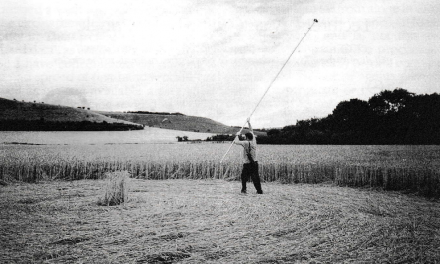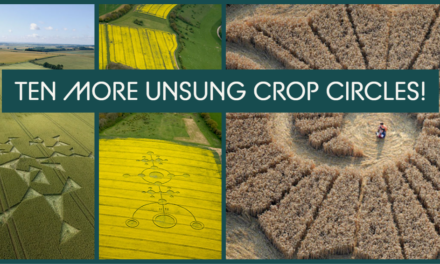
Ten Epic Crop Circle Locations

When looking at a crop circle it’s easy to overlook the landscape surrounding it. Yet, to The Croppie, the landscape and ambiance around a circle is just as important as the formation itself; after all, and to quote a wag from 2010, who wants to visit a crop circle next to an industrial estate? Here, then, are ten of the most wonderful locations to have played host to the circle making force. Of course, there are many more places we could have included: Stonehenge, Hackpen Hill, Wilton Windmill and Barbury Castle being among the most obvious; and then there’s the Rollright Stones, the Long Man at Wilmington, Devil’s Den, Roundway, Danebury Hillfort, Maiden Castle, Old Sarum, Yarnbury Castle, Chilcomb Down and more besides… So many options! Therefore, please don’t treat this as a ‘top ten’ piece, but we think you’ll find it hard to disagree with our final three…
The Wrekin, Shropshire

The Wrekin, July 2012. Photograph by Jim Holmes.
Let’s begin with a place far away from the Wiltshire villages and landmarks that dominate this list. During 2012 three formations appeared close to The Wrekin, a partially-wooded, 400m high hill near Telford with dominating views of the Shropshire countryside. The circles themselves were unimpressive but the landscape around them is stunning with rich woodland, undulating terrain and patchwork fields. It’s a shame the circle makers don’t visit this area more often. Then again, perhaps more frequent stops would make farmers less naive. We can’t forget Mr Gwinn of Charlton Farm, near Walcott, who explained away the circle on his land: ‘It’s these clever youths … They go out and make them with a piece of wire.’
Chute Causeway, Wiltshire

Photograph by Hugh Newman
Roman roads criss-cross the English countryside, but Chute Causeway is different to most: it hugs the ridge of the hills above the tiny Wiltshire hamlet of Hippenscombe and has a wonderful view across to Fosbury Hillfort. A string of narrow fields flank the northern side of the road, each dropping away to their boundary with the steep incline beyond. It’s genuinely tough to find the words that do justice to such a stunning location.
Bratton Camp (Westbury White Horse), Wiltshire

Photograph by The Croppie
The white horse hill carving close to the Wiltshire town of Westbury sits alongside the iron age hillfort of Bratton Camp. It’s a location with its heart and soul entwined with both ufology (the nearby town of Warminster went through its own UFO flap in the 1960s) and crop circle history: in 1980 Doug Bower and Dave Chorley knew their circles would inevitably be seen by walkers taking in the view from the hilltop — on a clear day you can see towards Devizes, and the more distant Bristol and Somerset. Ten years later the BBC and Nippon TV chose Bratton Camp as the location to monitor the fields below them for the infamous Operation Blackbird cropwatch. Indeed, any crop circle set down underneath the Salisbury Plain escarpment in this small corner of Wiltshire is going to be extremely visible.
Cherington, Gloucestershire

Photograph by The Croppie
Very few crop circles have found their way upon the rolling hills of the Cotswolds but in 2014 one appeared just outside the tiny village of Cherington in Gloucestershire. Regardless of the season this is a special location: the lanes are narrow, the fields small and the ambience thoroughly peaceful.

Photograph by The Croppie
In fact it’s so quiet here that you can sit back and listen to the birds as they move from tree to tree. It’s one place where you can genuinely feel ‘away from it all’ and lost in time with the arched hangars from the former RAF Aston Down airbase visible in the distance.
Uffington & Wayland's Smithy, Oxfordshire

Photograph by Stonehenge Dronescapes
The first of three slight cheats on this list … we’re going to bundle three sites into one entry, all of which are close to the village of Uffington. First is the Uffington White Horse, a 350 foot long prehistoric hill carving. It is adjoined by Dragon Hill, a natural chalk mound with an artificially flattened top. Both hills dominate the arable fields below them, their slopes as daunting as the mysterious legends they hold. A mile or so away, above the village of Ashbury, is Wayland’s Smithy long barrow; a beautiful remain set within a copse alongside the ancient Ridgeway path. We’ve had some great circles in this area in the past … a shame the farmers aren’t particularly forgiving around this way.

Photograph by M S Emmett. Reproduced under a Creative Commons license.
Chilbolton Observatory, Hampshire

Photograph by The Croppie
As a species humanity is fascinated by the prospect of life on other planets. What better way to exploit this than to put down a succession of crop circles close to a radio telescope on the beautiful Hampshire Downs? And so, in 2001, Chilbolton Observatory entered into the top tier of crop circle lore as the site of the Arecibo reply formation; a allegedly extraterrestrial response to a radio signal beamed out into the darkness from Puerto Rico during 1974. Today, the observatory is an imposing, eerie and strangely isolated research facility lacking in charm but full of 1960s Cold War menace. Set on a plateau underneath the A30 near Stockbridge, it is situated on the now redundant RAF Chilbolton, an airbase used by Hurricane fighter planes during the Battle of Britain in 1940. The ghosts of those days are never far away as you walk around the flat, open site and stumble across air raid shelters and underground bunkers. You can certainly understand why the circle makers chose this weird, out-of-kilter place for some of their most memorable creations.

Photograph by Steve Alexander
Chesterton Windmill, Warwickshire

Photograph by TSfromthewastelands
A delightful landmark dating from the 17th century, Chesterton Windmill can be found on a peaceful hill around ten miles southeast of Royal Leamington Spa in Warwickshire. The windmill is notable for being constructed upon six tall arches, but that’s not the real reason we’re so much in love with the place: it’s the views. The gorgeous panorama of collaged fields is truly memorable at any time of year, but even more so at the end of July and into August when the wheat is ripening. The Croppie has spent long evenings here all alone without wishing to leave. We need more crop circles here sooner rather than later.
Cheesefoot Head, Winchester, Hampshire

Cheesefoot Head, near Winchester, Hampshire; August 2012. Photograph by Steve Alexander
One of the most famous locations in crop circle history, Cheesefoot Head is also one of the most beautiful. This weirdly named peak reaches 176m and is situated to the east of Winchester on the edge of the South Downs. Just underneath the hilltop the land drops away into what’s known these days as the Matterley Bowl (Doug Bower and Dave Chorley always referred to it as the Devil’s Punchbowl). This natural amphitheatre now hosts the annual Boomtown Festival, but in the 1980s it was routinely planted with cereal crops.
Although the Matterley Bowl will probably never see another crop circle we can be happy that just across the A272 is Longwood Warren; a succession of long, sloping arable fields with views down towards the Solent. Wherever you look in this area there is something wonderful to be seen.

Crop Circle at Longwood Warren, adjacent to Cheesefoot Head, in 2020. Photograph by Steve Alexander
Alton Barnes & Alton Priors, Wiltshire

Photograph by Steve Alexander/Temporary Temples
Anyone who has travelled by car from Devizes towards Pewsey can account for the natural beauty of the landscape. Time stands still in these parts and only the road and its traffic betrays the fact you’re in the 21st rather than 18th century. The minor road traces the southern escarpment of the Marlborough Downs and is flanked on both sides by picturesque arable land. Climb those hills and you’ll be blessed with a wonderful view along the Vale of Pewsey with sights including the small twin villages of Alton Barnes and Alton Priors.

Photograph by The Croppie
Is it any wonder the circle makers came here in July 1990 and made themselves resident for the next twenty years? Anything they made could be clearly seen from the hilltops. Indeed, it was nothing unusual to bump into croppies who would eagerly tell you how they’d spent the previous night wrapped up under a blanket watching the fields from ancient hillfort on Knap Hill. From that point, or on top of neighbouring Walkers Hill, you could get some perspective on any circles that had appeared in a number of circles hotspots including East Field, the Alton Barnes White Horse under Milk Hill, South Field, Honeystreet, Tawsmead Copse, Golden Ball Hill and Stanton St Bernard.

Photography by Nick Bull
Croppies used to call Alton Barnes ‘Ground Zero’ and it’s a little sad to know those stories about ‘Alien Alley’ and the East Field Silage Pit are now just individual memories rather than common croppie knowledge. Even The Barge Inn at neighbouring Honeystreet is no longer a pub for croppies; these days it is no different to any pub that accommodates alternative, crusty types. No matter, the area is still prime crop circle country, even if the long-suffering farmers are (with very good reason) far less tolerant than they used to be.

Tawsmead Copse, nr Alton Priors, Wiltshire; July 2022. Photograph by TSfromthewastelands
Avebury, Wiltshire

Crop Circle 2021 Photograph by Stonehenge Dronescapes
If ever there was a no-brains winner to be posted in a list on The Croppie then it’s this one: the Avebury World Heritage Site truly is the most epic location in which crop circles have appeared. The UNESCO designated site is brimming with prehistoric history and well known locations from the cerealogical archives including Windmill Hill, The Ridgeway, Beckhampton, The Sanctuary, East Kennett and West Kennet Long Barrow. Of course, the two best known spots in the area are Avebury Henge (which contains the largest stone circle in the world) and Silbury Hill, the latter being a man-made chalk mound.
Regrettably, the agricultural community in the Avebury locale have become largely intolerant of crop circles in the 21st century, a situation not helped by one well known idiot who vandalised circles on the land of a major farmer in the area. Fortunately, after a quiet few years, some formations are escaping the chop, including that featured above from 2021.
With or without circles Avebury is blessed with a rolling, sacred landscape full of memory and legend. Click here for more on the National Trust website.
If you’re not fortunate enough to have visited Avebury then check out these incredible photographs by Stonehenge Dronescapes:

Avebury Henge and village. Photograph by Stonehenge Dronescapes.

Silbury Hill. Photograph by Stonehenge Dronescapes.

West Kennet Long Barrow. Photograph by Stonehenge Dronescapes

Avebury stones. Photograph by Stonehenge Dronescapes





